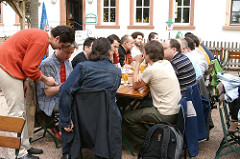During practical RDF projects, one big challenge is always how to choose good URIs for your resources. The RDF standards say very little about this topic. There are some best practices and helpful recommendations, but they are scattered all over the web. Creating “cool URIs for the semantic web” is hard.
Richard Cyganiak, Max Völkel and myself have written an article about how to choose cool URIs, filled with practical knowledge and background information about the problem and solutions. We have collected what we have learned during projects such as Semantic MediaWiki, dbpedia, D2R Server, Gnowsis, and Nepomuk. We hope that this article is a help for you or your students to get started programming Semantic Web applications.
Read it
- Cool URIs for the Semantic Web (html)
- Cool URIs for the Semantic Web (PDF version)
Abstract
The Resource Description Framework RDF allows you to describe web documents and resources from the real world—people, organisations, things—in a computer-processable way. Publishing such descriptions on the web creates the semantic web. URIs are very important as the link between RDF and the web. This article presents guidelines for their effective use. We discuss two strategies, called 303 URIs and hash URIs. We give pointers to several web sites that use these solutions, and briefly discuss why several other proposals have problems.
Notice: we have written the article late last year, but published it this year. You can republish or copy this article under the Creative Commons Attribution-NoDerivs 2.0 License.






